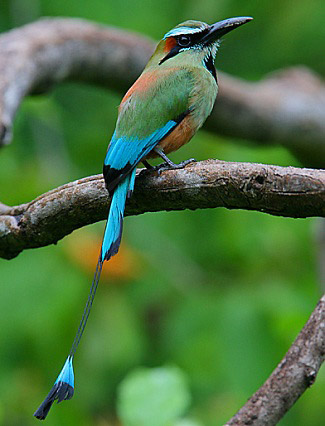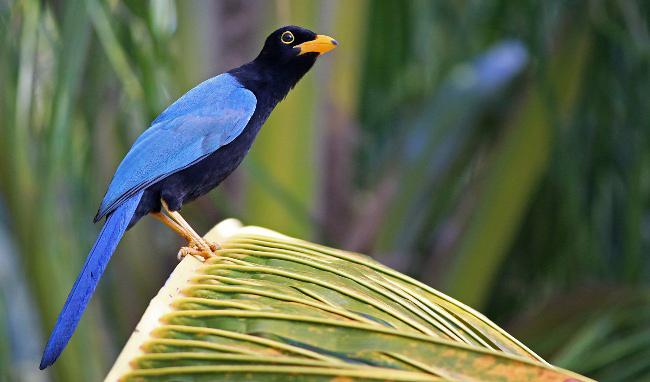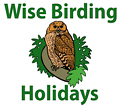

The fabulous Turquoise-browed Motmot, by Steve Garvie.
- Some of Mexico's 1000 or so bird species, of which over 120 are endemic and over 200 are regionally endemic, totals which in Southern Mexico include several Yucatan specialities, such as Ocellated Turkey, Mexican Sheartail, Yucatan Jay and Orange Oriole
- And some of Mexico's and the world's other most spectacular birds including American Flamingo, Magnificent Frigatebird, Keel-billed Toucan, Blue-diademed and Turquoise-browed Motmots, Rufous-tailed Jacamar, Lovely Cotinga and Red-capped Manakin
- Possibly the best place in the world to swim with Whale Sharks
- As well as Manta and Eagle Rays, over rich coral reefs
- While, back on land, there are Black Howler and Spider Monkeys
- All in some fine settings
- Mexico is a huge country. Even two weeks is not enough to cover much of Southern Mexico, although it is just half a day's drive (with no birding stops!) from Palenque, included here, to the highland town of San Cristobal de las Casas, not included here and around which many different birds occur, including such spectacular species as Blue-throated Motmot (most likely in Reserva Huitepec), Blue-and-white Mockingbird, many warblers including Golden-cheeked and Pink-headed Warblers, and Hooded Grosbeak.
- It is also a half day's drive from Palenque to Bonampak where the possibilities include Scarlet Macaw, Black-crested Coquette, Purple-crowned Fairy, White-whiskered Puffbird and Lovely Cotinga. This is near Guacamaya Lodge in Montes Azules NP where it is possible to see Great Curassow, Scarlet Macaw, Keel-billed Toucan and Red-capped Manakin (at lek), as well as Montebello NP where Resplendant Quetzal is present but thin on the ground and elusive.
- Other destinations in Mexico include Veracruz, where the world's greatest raptor migration takes place in the autumn/fall, usually peaking from late September to mid-October, Central Mexico, where millions of Monarch butterflies spend the northern winter, and Baja California where it is possible to see hundreds of whales and thousands of dolphins from February to early April.

The stunning Yucatan Jay by Ian Davies.
Best Birds and other wildlife in Southern Mexico
Birds
Endemics
Yucatan Peninsula 2 Yucatan (White-lored) Gnatcatcher and Yucatan Wren.
Cozumel Island 4 Cozumel Emerald, Cozumel Vireo, Cozumel Wren and Cozumel Thrasher (may be extinct).
Other Yucatan Specialities
Yucatan Bobwhite, Ocellated Turkey, Yucatan (Yellow-lored) Parrot (Amazon), Yucatan Poorwill, Yucatan Nightjar, Mexican Sheartail (endemic to Mexico),
Yucatan Woodpecker, Black Catbird, Yucatan Flycatcher, Yucatan Jay, Rose-throated Tanager, Green-backed Sparrow and Orange Oriole.
Others
Great Curassow, American Flamingo, Bare-throated Tiger Heron, Boat-billed Heron, Reddish Egret, Pinnated Bittern, Magnificent Frigatebird, King Vulture,
American Swallow-tailed and Snail Kites, Black-collared and White Hawks, Crested Caracara, Bat and Laughing Falcons, Collared Forest Falcon, Russet-naped
(Grey-necked) Wood Rail, Limpkin, Double-striped Thick-knee, Northern Jacana, Black Skimmer, pigeons including White-crowned, parrots, owls including
Mottled, Northern Potoo, hummingbirds including Violet Sabrewing, trogons, Blue-diademed (Lesson's) and Turquoise-browed Motmots, Belted, Green, Amazon
and American Pygmy Kingfishers, Rufous-tailed Jacamar, White-necked Puffbird, Keel-billed Toucan, Collared Aracari, woodcreepers, Scaled Antpitta,
Red-capped Manakin, Lovely Cotinga, Masked and Black-crowned Tityras, many flycatchers including Fork-tailed, Scissor-tailed and Vermilion, Green Jay,
wrens, Long-billed Gnatwren, Wood Thrush, wintering warblers including Magnolia, Yellow-throated, Blue-winged, Swainson's, Kentucky and Prothonotary,
Ovenbird, Green and Red-legged Honeycreepers, Painted Bunting, orioles, and Chestnut-headed and Montezuma Oropendolas. Also a chance of tinamous, Jabiru,
Aplomado Falcon, Spotted Rail, Sungrebe, Crested Owl, Northern Royal Flycatcher and Black-throated Shrike Tanager.
Mammals
(Yucatan) Black Howler and Central American (Black-handed/Geoffroy's) Spider Monkeys, Central American Agouti and
Grey Fox.
Reptiles, Amphibians and Fish
Whale Shark (Jun-Sep, mostly July - one of the largest gatherings on Earth, feeding on fish
eggs and plankton, especially around Islas Holbox and Mujeres), Mexican (Morelet's) Crocodile, Manta Ray, Spotted Eagle Ray (usually in large numbers
around Isla Cozumel in Jan-Feb), and Green and Hawksbill Turtles.
Best Sites for Birds and other wildlife in Southern Mexico
- Yucatan Peninsula
- Isla Holbox Whale Shark, Manta Ray, Green and Hawksbill Turtles, American Flamingo and Magnificent Frigatebird.
- Isla Mujeres Whale Shark.
- Isla Cozumel endemic hummingbird, vireo, wren and very rare, possibly extinct, thrasher, Magnificent Frigatebird, Ruddy Crake, White-crowned Pigeon, Caribbean Dove, Green-breasted Mango, Yucatan Woodpecker, Black Catbird, wintering warblers such as Magnolia and Yellow-throated and Orange Oriole. Also a rich marine life with Spotted Eagle Rays.
- Rio Lagartos Yucatan Bobwhite, American Flamingo, Bare-throated Tiger Heron, Boat-billed Heron, Yucatan Parrot, Lesser Roadrunner, Canivet's Emerald, Mexican Sheartail, Yucatan Woodpecker, Yucatan Wren, Grey Fox and Mexican Crocodile.
- Chichen Itza One of the best preserved Mayan sites, with Bat Falcon, Turquoise-browed Motmot, Yucatan Jay and Orange Oriole.
- Coba A chance of Spotted Rail, Ruddy Crake, Northern Potoo and Black-headed Trogon.
- Felipe Carrillo Puerto (Sian Ka'an Biosphere Reserve) Collared Forest Falcon, Russet-naped Wood Rail, Yucatan Poorwill, Yucatan Nightjar, Wedge-tailed Sabrewing, Blue-diademed and Turquoise-browed Motmots, Keel-billed Toucan, Mayan (Mexican) Antthrush, Caribbean Elaenia, Yucatan Vireo, Yucatan Jay, White-browed Wren, Grey-throated Chat, Red-throated Ant Tanager, Rose-throated Tanager, Yellow-throated Euphonia, Green-backed Sparrow and Orange Oriole. Also a chance of Stub-tailed Spadebill.
- Uxmal Blue-diademed and Turquoise-browed Motmots, Yucatan Jay, Grey-throated Chat and Orange Oriole.
- Rio Celestun NP American Flamingo, Magnificent Frigatebird (possibly perched), Boat-billed Heron, Reddish Egret and American Pygmy Kingfisher.
- Calakmul Great Curassow, Ocellated Turkey, Yucatan Poorwill, Mayan (Mexican) Antthrush, Swainson's Warbler, Grey-throated Chat, Black Howler and Central American Spider Monkeys, and Central American Agouti. Also a chance of Northern Royal Flycatcher and Black-throated Shrike Tanager.
- Cueva de los Murcielagos hundreds of thousands of bats, mainly Broad-eared.
- Northern Chiapas
- Usumacinta Marshes Bare-throated Tiger Heron, Boat-billed Heron, Pinnated Bittern, Snail Kite, Black-collared Hawk, Russet-naped Wood Rail, Double-striped Thick-knee, Northern Jacana, Amazon Kingfisher, and Fork-tailed and Scissor-tailed Flycatchers. Also a chance of Jabiru, Aplomado Falcon and Sungrebe.
- Palenque Black Howler Monkey, White Hawk, Northern Potoo, Violet Sabrewing, Black-headed and Collared Trogons, Blue-diademed Motmot, Rufous-tailed Jacamar, White-necked Puffbird, Keel-billed Toucan, Collared Aracari, Chestnut-coloured Woodpecker, Scaled Antpitta, Mayan (Mexican) Antthrush, Red-capped Manakin, Lovely Cotinga, Masked and Black-crowned Tityras, Green Shrike Vireo, Long-billed Gnatwren, Worm-eating, Kentucky and Prothonotary Warblers, Ovenbird, Green and Red-legged Honeycreepers, Yellow-winged and Crimson-collared Tanagers, Black-throated Shrike Tanager, and Chestnut-headed and Montezuma Oropendolas. Also a chance of tinamous, Crested Owl, Tody Motmot and Northern Royal Flycatcher.
Best Times for Birds and other wildlife in Southern Mexico
The best time for Whale Sharks is June to September, especially July. Many birds can also be seen at this time but the birdlife is bolstered by wintering birds, notably warblers from North America, between October and March, and March-April is the peak time for birds because many wintering species are still present, migrating birds are moving through and many resident species are breeding and therefore at their most active.
Recommended Bird Books etc. for Southern Mexico
Travellers' Wildlife Guides: Southern Mexico by L Beletsky. Arris Books, 2006.
A Field Guide to the Birds of Mexico and Northern Central America by S Howell and S Webb. OUP, 1995.
A Field Guide to Mexican Birds by R Tory Peterson and E Chalif. Houghton Mifflin, 1999.
Where to watch birds in Mexico by S Howell. Helm, 1999.
National Audubon Society Field Guide to Tropical Marine Fishes by C L Smith. Alfred A Knopf, 1997.
A Field Guide to the Mammals of Central America and Southeast Mexico by F A Reid. OUP, 2009 (Second Edition).
A Swift Guide to the Butterflies of Mexico and Central America by J Glassberg. Sunstreak Books, 2007.
Where to watch birds in Central America & the Caribbean by N Wheatley and D Brewer. Helm, 2001.
Don’t know which country/countries/regions to visit in Central America? Then it may be worth considering taking a look at this book, written by this website’s author and David Brewer. It is many years old of course but it still provides a starting point, an overview and a guiding light to the best birds and the best places to look for them in the region, and could save hours of searching for similar information on the internet. However, it is important to check more up-to-date sources for sites which have been opened up, sites and species which have been discovered, lodges that have been built etc. since the book was published.
Birding and Wildlife Trip Reports for Southern Mexico
Many trip reports, some for Southern Mexico, are posted on the websites listed here. On some of these websites some reports are independent and some are posted by tour companies who organize tours to Southern Mexico. These tour companies and others also post their own reports on their websites, which are listed under 'Some Organized Tours to Southern Mexico' below.
- The best website for trip reports is CloudBirders
- but these are also worth a look
- Birdtours
- Fatbirder
- Jon Hornbuckle
- Mammal Watching
Local bird and wildlife guides in Southern Mexico
The costs of organized tours partly reflect the quality of the tour leaders. Some leaders are certainly better than others and many companies claim their leaders are the best but even the best rely at least to some extent on the exceptional skills of the local guides they employ. If you are travelling independently, employing such local guides will greatly increase your chances of seeing the wildlife you wish to see.
Accommodation for birders in Southern Mexico
Some Organized Tours for birds and other wildlife to Southern Mexico
There are many tour companies who organize tours to see mammals, birds, other wildlife and other natural wonders. The cost of these tours vary considerably according to such variables as the airlines used, the number of days the tours last, the number of sites visited, the number of people in the group (an important consideration if you wish to see such wildlife as rainforest mammals and birds), the number of tour leaders, the standard of accommodation and transport, and the percentage profit the company hopes to make. Generally, where the number of days tours last and the number of sites visited are similar, the cheapest tours are those that use the cheapest airlines, accommodation and local transport, that have the largest groups with the least number of leaders, and that make the least amount of profit. The most expensive tours tend to be those which are exceptionally long, use the most expensive accommodation (ridiculously lavish in some cases, even for single nights) and which make the most profit. Some tour costs partly reflect the quality of the tour leaders. Some leaders are certainly better than others and many companies claim their leaders are the best but even the best rely at least to some extent on the exceptional skills of the local guides they employ.
While tour companies organize tours with set itineraries many also organize custom tours for individuals and private groups who instead of taking a tour with a set itinerary want to follow their own itinerary to suit their own personal tastes, whether it be mammals, birds, other wildlife, other natural wonders or even man-made attractions, or a mixture of them all. Many organized tours with set itineraries are also fast-paced and target as many species as possible, whether they are mammals, birds or other wildlife or everything, which usually leaves little time to enjoy the best sites and individual species, but on a custom tour those taking part can specify the pace and the sites and species they wish to concentrate on. Custom tours also suit people who like to travel with people they already know, rather than with a group of strangers, and people with partners with different interests. Individuals and small groups will almost certainly have to pay more than the price of an organized tour with a set itinerary but a large group of friends may be able to travel for less than the price quoted for a set tour.
Tour companies who run organized tours or can arrange custom tours to Southern Mexico include the following.
- Birdquest
- Dive Worldwide
- Field Guides
- Legacy Tours
- MICHAEL CARMODY: specializes in the 100+ endemic bird species/forms of MEXICO. Contact LEGACY TOURS for a calendar of tours, or to arrange custom birding. E-mail: MDCarmody@Comcast.Net, Web site: LEGACY TOURS, or call our USA based office: (509) 624-1889. Serious REFERENCES from many top World and North American Listers.
- Wings

